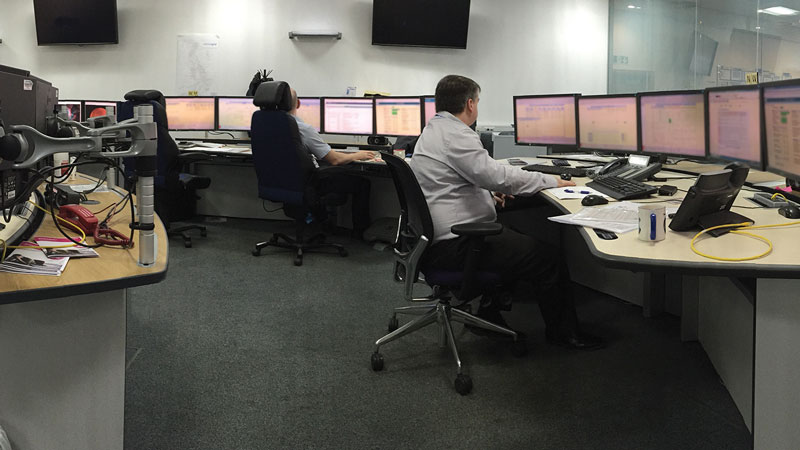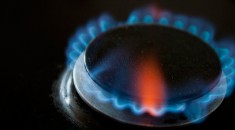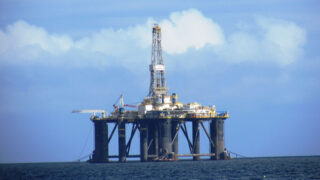05.45: Across the silhouetted fields and trees to the east, an angry streak of colour is splitting the earth from the sky. Sunrise is 45 minutes away and the houses in this part of Leicestershire show only the darkness of continuing slumber. But in one corner of Hinckley, it’s simply the next part of a 24/7 day, as one shift prepares to clock off and another to clock on.
The National Grid’s Distribution Network Control Centre – or DNCC, as it’s more commonly known – is unobtrusively located behind heavy, secure doors on a big, bustling site, beyond a foyer where notices proclaim: ‘Safety is everyone’s responsibility’.
Jim Eldridge is a National Grid veteran; he’s been with the company for 29 years and with DNCC for 11 of those. The UNISON rep is part of the team that keeps the gas flowing across five networks in the UK – not only ensuring that there’s enough gas to fill the daily needs of those areas, but that the network remains safe for everyone.
06.45: Jim is preparing to take over the reins for the North West. He picks up detailed notes from the colleague who has just finished, and he’ll update these throughout his shift for the person who follows him.
07.00: It’s time to set up the array of six large screens that Jim will be watching over. They provide him with all sorts of data, including how much gas is in the pipes – or the Linepack, as the gas cognoscenti call it.
The team ensures that, a little like a night storage heater, the pipes are filled up as much as possible overnight – indeed, using this storage method is much cheaper than using the gas holders most of us are familiar with and, in part, explains the gradual disappearance of those iron giants from our landscape.
08.40: The team gathers together for the daily hub – a brief meeting with the shift manager – and then it’s back to their desks.
Jim has to help prepare a stretch of pipe near Manchester for an ‘early run’ with a ‘pig’. That’s not the snorting variety, but a tube-shaped piece of kit that can do all sorts of jobs inside a pipe, from magnetically picking up scraps of metal to checking for faults.
These gadgets have featured in three James Bond outings, including The Living Daylights, where a modified one transported a character beneath the Iron Curtain. A pig can’t simply be set off on a run at any time: the gas pressure needs to be at a precise level, so that the machine’s speed is as near as possible to its optimum of three and a half metres a second. Which is pretty pacey.
Jim releases extra gas into the system from as nearby as possible. He’s regularly taking calls from an engineer in the field, who’s itching to start. The projected time for the pig to be let out of the traps is 9am, but gas doesn’t always play by the rules: today, it’s taking longer to get the pressure to rise to what is needed.
Pigs are expensive pieces of kit, but they are an incredibly effective way of checking the pipes and, therefore, saving money. Although, as Jim points out: “Protecting life is our number one priority. The cost to National Grid is very much secondary”.

09.10: Eventually, the pig is able to start it’s 7km journey and Jim can get on with the first of the forecasts he has to prepare during his shift. These take various factors into account – from the weather to the time of year – to help him come up with a figure for how much gas his region will need tomorrow.
If he gets it wrong, the consequences can be anything from people not being able to cook their dinner to National Grid being fined for having to grab in unscheduled gas.
There are two peaks of usage during the gas day: at around 8am when people rise and get ready for work and school, and when they return home, pop the kettle on and, if it’s chilly, put the heating on.
The North West alone uses around 27 million cubic metres of gas every day – that’s the starting point and it can go up a lot during a freeze. But temperature isn’t the only weather factor that affects the amount of gas used – rain can too.
The industry is changing. Not only are Jim and his colleagues each doing a job that, many years ago, would have taken five people, the way that gas is generated is changing too.
For instance, National Grid now has sites that generate bio-gas from waste food and from sewerage. Since the tech is still developing, they’ll become more cost effective over time.
Shale gas could be on the cards too – something about which Jim remains carefully neutral; his job, he explains, is simply to manage the gas in the safest way possible, wherever it comes from.
09.50: As the pig run reaches its final few minutes, it’s time to start carefully lowering the pressure in the pipes.
And since the pig has stirred up some muck on its way down the pipe, arrangements are made with another engineer to replace clogged filters.
10.35: It’s time to start putting together reports for the company’s commercial customers in the area: these are emailed directly to those companies, so that they can check on their gas usage and let Jim know if they will need more or less the following day – vital for those forecasts.
11.10: The gas network is full of sensors; beeps regularly sound around the office, as alarms tell the team of potential faults. Resolution can be simple – or not, and in some cases, Jim will have to coordinate with people more locally based who can deal with on-site checks and repairs.
He enjoys the work. The company treats the staff decently, he says, adding that they’re paid well – but then again, they have a lot of responsibility. Nobody takes lengthy breaks during a shift; concentration and alertness are as essential in the control room as they would be on the bridge of a ship.
Noon: Martin, the shift manager, is keen to illustrate the potential consequences if anything goes wrong. He has a number of brief films on his computer that show pipes ripped apart like a zip by explosions, or huge fires bursting out of the ground if a damaged pipe gives out.
The atmosphere may be calm, but it’s a serious business – and that’s why training takes a good 18 months.
13.15: The pig has been damaged during its run. Nobody knows why, but it’ll be sent to Newcastle to be repaired and they’ll have to go through it all again later in the week.
After so many years on the job, Jim says that some of the tweaking becomes almost a matter of instinct. But he brought his daughter in one day for work experience, only to overhear her later, telling his wife that dad played with “a big video game”.
And then, with his own handover notes fully updated, it’s time to pass control to the afternoon shift and head out to the rather more old-school tech of his Union Flag-topped Mini Cooper.
The Hinckley job is done – until tomorrow.






